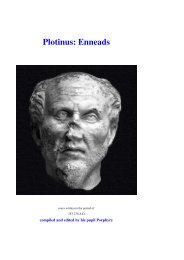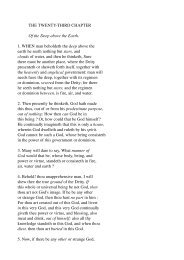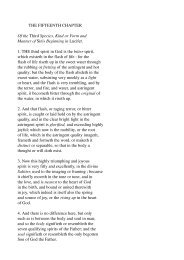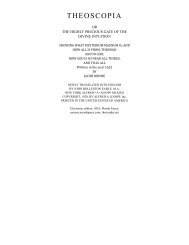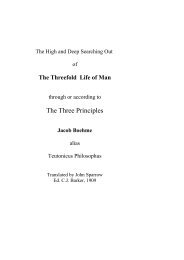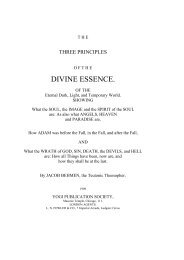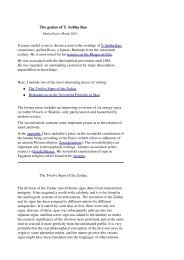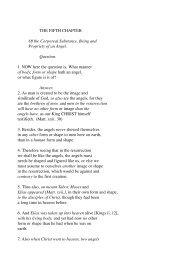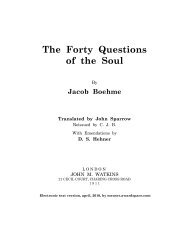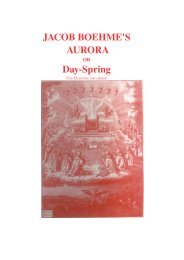Gerald Massey's Lectures - Society in evolution - Awardspace
Gerald Massey's Lectures - Society in evolution - Awardspace
Gerald Massey's Lectures - Society in evolution - Awardspace
Create successful ePaper yourself
Turn your PDF publications into a flip-book with our unique Google optimized e-Paper software.
the act of ador<strong>in</strong>g his own spiritual image, the glorified Eidolon, to which he relates how<br />
he abom<strong>in</strong>ates all filthy th<strong>in</strong>gs, <strong>in</strong> order that his ka, or higher self, may be propitiated and<br />
pleased. The Egyptian title of ka-ankh meant the liv<strong>in</strong>g likeness, or the likeness of the<br />
immortal, the one that lived on after death. Moreover, this ka was not only the reflex<br />
image of the defunct erected <strong>in</strong> the tomb; it was also pourtrayed as be<strong>in</strong>g born with the<br />
mortal <strong>in</strong>to this life. In the scenes at Luxor, <strong>in</strong> which Amenhept III. is represented at the<br />
moment of birth, another <strong>in</strong>fant, his exact likeness, is depicted as his ka, his genius,<br />
himself <strong>in</strong> a div<strong>in</strong>e effigy. Also, it was a great joy for the spirit of the deceased to be<br />
permitted to revisit the dead body and see how carefully it was preserved, which shows<br />
us the f<strong>in</strong>al crown<strong>in</strong>g motive for mak<strong>in</strong>g and keep<strong>in</strong>g the Mummy. In the chapter<br />
(lxxxix.) of the visit of the soul or Ka of the deceased to his body, it is said,--"Thou hast<br />
let my eternal soul see my body!" "He sees his body;" and "He is at peace <strong>in</strong> his<br />
Mummy!"<br />
The chief fact with which we are now concerned, is, that the Mummy-image supplied the<br />
supreme type of transformation, and was the Egyptian Karast, or Christ. Various symbols<br />
of durability and rebirth were buried with the Egyptian dead, when the mummy was<br />
deposited <strong>in</strong> the hen-ankhu, or chest of the liv<strong>in</strong>g. A copy of the Book of the Second<br />
Breath--Sen-sen--formed his pillow, and the leaves of the Book of Life were the l<strong>in</strong><strong>in</strong>g of<br />
his coff<strong>in</strong>. He was accompanied by his types of protection, of duration, and renewal, the<br />
ankh-cross of life to come; the ankham-flower of life, worn at the ear, the tat-cross, or<br />
buckle of stability, the beetle of transformation, the vulture-image of victory; the greenstone<br />
(Uat) of revivification, the tablet of ros<strong>in</strong>, a type of preservation; the Level or<br />
corner-sign of Amenu, signify<strong>in</strong>g to come--our "amen." And, with the eyes of the sun and<br />
moon to light him through the darkness, the Egyptian entered his tomb, called the "Good<br />
Dwell<strong>in</strong>g." A number of copies of the Shebti, or double of the dead, were ranged <strong>in</strong> the<br />
Serdab to signify manifold repetition, and the Ka-image of his spiritual self was erected<br />
<strong>in</strong> the tomb, as his visible l<strong>in</strong>k with his dead form on earth. But, the Mummy itself was<br />
also preserved as a type, just as the mummified hawks, mice, cats, and other animals,<br />
were preserved for their typical significance. Both Herodotus and Plutarch tell us how the<br />
Egyptians ended a banquet by carry<strong>in</strong>g round, <strong>in</strong> a coff<strong>in</strong>, the image of a dead body.<br />
"Look on it, they said, and dr<strong>in</strong>k, for when you are dead you will be like this!" That<br />
image was the mummy-type of immortality! The sentiment was not that of "Eat and<br />
dr<strong>in</strong>k! for to-morrow we die!" It was one of rejoic<strong>in</strong>g <strong>in</strong> the assurance of immortality<br />
which the mummy-image represented. This mummy-image was the Egyptian Corpus<br />
Christi, the body of Christ, or spirit which was to be reborn. We have to go a long way<br />
back to get at the orig<strong>in</strong> of the types and symbols now called Christian; not one of these<br />
orig<strong>in</strong>ated at the beg<strong>in</strong>n<strong>in</strong>g of our era! The Christ, for <strong>in</strong>stance, is a pre-Christian type,<br />
connected with the mask, the mummy, and the mysteries of transformation.<br />
The first male type of the Christ was after the flesh, and founded on the transformation of<br />
the boy <strong>in</strong>to man--the Christ who became the ano<strong>in</strong>ted one of puberty. This Phallic fetish<br />
associated with the rite of circumcision was the one repudiated by Paul for the spiritual<br />
Christ--not the historical Jesus. In the Gnostic sense the word made s£rx, or flesh, was<br />
this Phallic Logos founded on the Causative Seed; the reproductive power which<br />
transformed <strong>in</strong> this life hav<strong>in</strong>g been made a type of transformation for the future life! In<br />
the Gospel accord<strong>in</strong>g to Thomas, it is said--"He who seeks me will f<strong>in</strong>d me <strong>in</strong> children<br />
from seven years old; for there concealed I shall, <strong>in</strong> the fourteenth year, be made<br />
manifest"--that is, as the pubescent Christ or Horus. In Greek the Christ means the<br />
ano<strong>in</strong>ted; but the mystical or spiritual sense of the word was preceded by the physical.<br />
Chriso and Chresthai are also names for daub<strong>in</strong>g over with colour<strong>in</strong>g matter; and it still<br />
is a primitive practice amongst the Black men and Red men to cover the bodies or bones<br />
of the dead with red ochre. Human bones buried <strong>in</strong> the mounds of Caithness have been<br />
found coated over with red earth. This was done to preserve and save them. It was also



